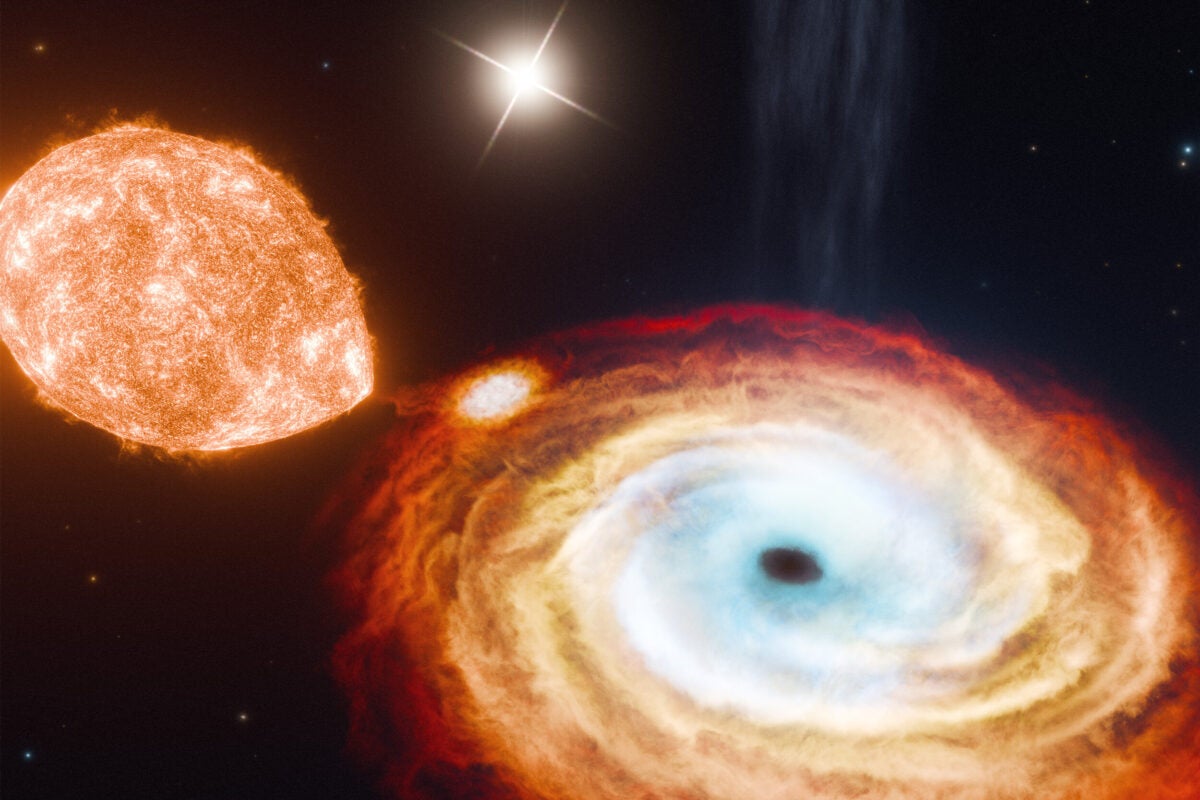
Despite their destructive forces, black holes are often seen in with a companion, such as a star, neutron star, white dwarf, or even another black hole. However, a study published Oct. 23 in Nature has found that the black hole binary system V404 Cygni, which contains a black hole and a small star, has an additional friend — a second star that lies about 3,500 times farther from the “original” binary than Earth’s distance from the Sun.
This is a rare find. The team of researchers from MIT and Caltech were originally searching for signs of new black holes within the Milky Way. But then study lead author Kevin Burdge, a Pappalardo Fellow at MIT, happened upon the third member of V404 Cyg while using Aladin Lite, an online visualization tool that consolidates several surveys. He noticed there was an extra blob suspiciously close to the V404 Cyg system in visible wavelengths.
The find now has astronomers questioning the mechanisms behind the formation of black holes, how they interact with their companions, and whether there are more triple systems. V404 Cyg may be the first evidence for the idea that black holes can form in a gentler, less dramatic way than traditionally thought, allowing them to keep a distant star gravitationally bound and not eject it into space.
A second blob of light
V404 Cyg has been observed since 1992 and was one of the first confirmed black holes. The previously known blob of light Burdge saw in Aladin Lite is caused by the system’s inner star feeding the black hole and creating a bright accretion disk. However, the second blob — the light from a single star — must have long been overlooked.
To confirm whether the star was bound to V404 Cyg, the team used data from ESA’s Gaia survey to watch the known and potential companion stars move over the past 10 years. The two stars appeared to be moving together when compared to other nearby stars, making it clear that both are orbiting the black hole and proving V404 Cyg is the first “black hole triple.”
The outer star is weakly bound to the black hole and its inner star. In a press release, Burdge likened it to a situation where “you’re pulling a kite, and instead of a strong string, you’re pulling with a spiderweb. If you tug too hard, the web will break and you’ll lose the kite. Gravity is like this barely bound string that’s really weak, and if you do anything dramatic to the inner binary, you’re going to lose the outer star.”
But astronomers have long believed that black hole formation is a violent process. So, how has this outer star, connected by only a cosmic spiderweb, stayed put? That’s what’s making astrophysicists consider alternate black hole formation processes that have never previously had support from observations.
Explosion or direct collapse?
In the early 1970s, astronomers realized that supernovae could form black holes — and it’s been the accepted mechanism ever since. But when a supernova occurs, material and energy are expelled outward. This should blow away any faraway companions with only tenuous connections, such as V404 Cyg’s third star.
Instead, perhaps the black hole in this system underwent an unusually quiet death where the dying star imploded in what is known as direct collapse. This does not expel energy and thus would not eject the outer star.
To determine whether this was likely, the team ran tens of thousands of simulations to see whether they could end up with the current trinary system. Each model started with three stars, with one dying either as a supernova or undergoing direct collapse. When the supernova exploded outward, the third star stood no chance of staying in the system. But if the star imploded, the probability of the system remaining a triple increased significantly.
“The vast majority of simulations show that the easiest way to make this triple work is through direct collapse,” said Burdge.
Additional finds
V404 Cyg’s inner companion has an orbital period of only 6.5 days. But the outer star takes a whopping 70,000 years to complete a single orbit around the black hole, highlighting just how weakly bound it must be. That outer star is also aging and starting to become a red giant. This was a key clue that helped researchers determine the age of the system.
Using evolutionary models, the team deduced that the outer star formed about 3-5 billion years ago. Because the three stars (one of which is now a black hole) were likely born together, that makes the entire system, black hole and all, also the same age. They also found that the black hole has consumed at least half a solar mass of matter from its closer star.
This discovery holds plenty of potential for understanding the formation and evolution of stars, black holes, and nearby companions. “This system is super exciting for black hole evolution, and it also raises questions of whether there are more triples out there,” said Burdge.









